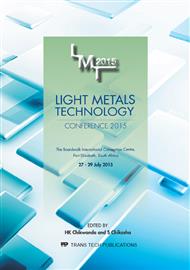[1]
R. Yang, Y. Hao and S. Li, Development and Application of Low-Modulus Biomedical Titanium Alloy Ti2448, Biomedical Engineering Trends, 10 (2011) 225-247.
DOI: 10.5772/13269
Google Scholar
[2]
A. Biswas, Porous NiTi by thermal explosion mode of SHS: processing, mechanism and generation of single phase microstructure, Acta Materialia, 53 (2005) 1415–1425.
DOI: 10.1016/j.actamat.2004.11.036
Google Scholar
[3]
T.M. Keaveny, E.F. Morgan, and O. C. Yeh, Bone Mechanics, Standard Handbook of Biomedical Engineering and Design, Chpt. 8, (2004), McGraw-Hill, www. digitalengineeringlibrary. com.
Google Scholar
[4]
Y-h. Li , Li-j. Rong, and Yi-yi Li, Pore characteristics of porous NiTi alloy fabricated by combustion synthesis, Journal of Alloys and Compounds, 325 (2001) 259–262.
DOI: 10.1016/s0925-8388(01)01382-2
Google Scholar
[5]
S.L. Zhu, X.J. Yang, D.H. Fu, L.Y. Zhang, C. Y Li, and Z.D. Cui, Stress–strain behaviour of porous NiTi alloys prepared by powders sintering, Materials Science and Engineering A, 408 (2005) 264–26.
DOI: 10.1016/j.msea.2005.08.012
Google Scholar
[6]
Yang F.B. Gabbitas, A. Mukhtar, and W. Downing, Preparation of Titanium Alloy Rods by Powder Compact Extrusion, Advanced Materials Research, 1019 (2014) 241-247.
DOI: 10.4028/www.scientific.net/amr.1019.241
Google Scholar
[7]
A. Tarik and B. Sakir, Enhanced Sintering of TiNi Shape Memory Foams under MgVapor Atmosphere, The Minerals, Metallurgical and Materials Transactions, 43A (2012) 5173-5181.
DOI: 10.1007/s11661-012-1350-y
Google Scholar
[8]
J. Sun, Y. Han, and K. Cui, Innovative fabrication of porous titanium coating on titanium by Cold spraying and vacuum sintering, Materials Letters, 62 (2008) 3623–3625.
DOI: 10.1016/j.matlet.2008.04.011
Google Scholar
[9]
C. L. Chu, P. H. Lin and C. Y. Chung, Characterization of transformation behaviour in porous Ni-rich NiTi shape memory alloy fabricated by combustion synthesis, Journal of Materials Science, 40 (2005) 773– 776.
DOI: 10.1007/s10853-005-6321-x
Google Scholar
[10]
C.T.C. Crombie and D.C. Blaine, Thermo-Gravimetric Analysis and Debinding Study of Powder Injected Moulded Titanium Alloy, Advanced Materials Research, 1019 (2014) 210-217.
DOI: 10.4028/www.scientific.net/amr.1019.210
Google Scholar
[11]
M. H. Elahinia, M. Hashemi, M. Tabesh, and S. B. Bhaduri, Manufacturing and processing of NiTi implants: A review, Progress in Materials Science, 57 (2012) 911–946.
DOI: 10.1016/j.pmatsci.2011.11.001
Google Scholar
[12]
A. Papyrin, V. Kosarev, S. Klinkov, A. Alkimov, and V. Fomin, Cold Spray Technology, Elsevier Ltd, (2007).
DOI: 10.1016/b978-008045155-8/50004-1
Google Scholar
[13]
Y. Zhou, C-J. Li, G-J. Yang, H-D. Wang, G. Li, Effect of self-propagating high-temperature combustion synthesis on the deposition of NiTi coating by cold spraying using mechanical alloying Ni/Ti powder, Intermetallics, 18 (2010) 2154e2158.
DOI: 10.1016/j.intermet.2010.07.006
Google Scholar
[14]
R. Contro, D. Gastaldi and G. Franzoso, Assessment of the Biomechanical Compatibility of an Interspinous Implant for Dynamic Stabilization, through the Finite Element Method, Journal of Mechanics in Medicine and Biology, 05 (2005) 375.
DOI: 10.1142/s0219519405001515
Google Scholar
[15]
A. Hamweendo, P. A. I. Popoola, and I. Botef, Mathematical Model for predicting process parameters in Cold spray of porous Ti Coating, Proceedings of the 1st International Conference on Mathematical Methods and Computational Techniques in Science and Engineering, Greece, 37 (2014).
Google Scholar
[16]
M. Gaško, and G. Rosenberg, Correlation between Hardness and Tensile Properties in Ultra-High Strength Dual Phase Steels – Short Communication, Materials Engineering, 18 (2011) 155-159.
Google Scholar


